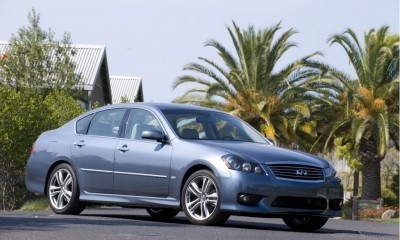 Nissan just recalled more than 161,000 defective cars. The M35 and M45 sedans of model years 2006 to 2010 could have accelerator pedal sensors that deteriorate. The sensor could send incorrect signals to the engine, causing it to stall while the vehicle comes to a stop or is idling, Nissan said.
Nissan just recalled more than 161,000 defective cars. The M35 and M45 sedans of model years 2006 to 2010 could have accelerator pedal sensors that deteriorate. The sensor could send incorrect signals to the engine, causing it to stall while the vehicle comes to a stop or is idling, Nissan said.
Product Liability – Defective Car: Doors in some Mazda6 sedans could open while the cars are in motion
 Mazda just recalled 161,400 defective cars in the US because loose screws can cause the side doors to come open while the car is being driven. All Mazda6 produced during 2009 to 2013 at a plant in Flat Rock Michigan are affected. Mazda will apply a thread-locking adhesive to the screws and re-tighten them free of charge. The recall is expected to begin by October 18
Mazda just recalled 161,400 defective cars in the US because loose screws can cause the side doors to come open while the car is being driven. All Mazda6 produced during 2009 to 2013 at a plant in Flat Rock Michigan are affected. Mazda will apply a thread-locking adhesive to the screws and re-tighten them free of charge. The recall is expected to begin by October 18
Product Liability – Defective Car: another car recall related to defective brake booster for BMW
76,000 defective cars are being recalled by BMW. According to BMW the oil supply for the vacuum pump that operates the brake booster used for power assist can be “interrupted”. The brakes will still function, but the driver will have to press much harder on the brake pedal. That means stopping distances could be greater.
Cars affected are the 2012-14 320i and 328i, and the 320i and 328i xDrive Sedan; the 2013-14 328i xDrive Sports Wagon; the 2012-13 528i and 528i xDrive Sedan; the 2013-14 X1 sDrive28i and X1 xDrive28i; the 2013-14 X3 xDrive28i and 2012-14 Z4 sDrive 2.8i
BMW has been experimenting issues with brake booster since 2010 with a total of 306,000 defective vehicle recalled since that year for that particular defect.
Medical Malpractice: Surgical Fire
Most Surgical Fires result from Medical Malpractice or negligence causing serious injury, disfigurement, and even death. They occur in, on or around a patient who is undergoing a surgical procedure. An estimated 550 to 650 surgical fires occur in the United States per year. Despite the fact that the root causes of surgical fires are well-understood, surgical fires still occur.
To promote actions to reduce the risk of risk of surgical fires.The Preventing Surgical Fires Initiative is celebrating its second anniversary during National Fire Prevention Week, October 6-12, 2013.
Fires happen during surgery because the 3 elements needed to start a fire (fire triangle) are present in an operating room:
Product Liability: FDA approves new boxed warning and new recommendations to decrease risk of hepatitis B reactivation with the immune-suppressing and anti-cancer drugs Arzerra (ofatumumab) and Rituxan (rituximab)
Cases of hepatitis B reactivation leading to serious personal injury and death after cancer patients have been prescribed Arzerra (ofatumumab) and Rituxan (rituximab) are still occurring even though the risk of HBV reactivation is already described in the Warnings and Precautions section of the labels for both drugs. For this reason the FDA has recently approved changes to the prescribing information of these two drugs.The revised labels also will include additional recommendations for screening, monitoring, and managing patients on these drugs to decrease this risk.
Go to the FDA website to learn more and listen to a podcast on this subject.
Medical Malpractice – Case and Commentary: preventing errors and adverse outcomes when prescribing opioids
Errors when prescribing opioids may constitute medical malpractice that can lead to the death of a patient. In the US, the use of opioids to treat chronic non-cancer pain has increased dramatically in recent years and because of their highly addictive nature, some patients may use prescribed opioids for non-medical purposes increasing their risk for injury or death.
Providers may make multiple errors when prescribing opioids for non-cancer pain. Most common errors are inadequate screening for safe and effective opioid use, inability to monitor adherence, improper selection of opioids and insufficient consideration of co-morbid conditions.
In a recent case study, Web Morbidity and Mortality analyses the case of a 42 year old man who died of an overdose after doctors did not follow appropriate prescription practices.
Product Liability: New car recalls for Nissan and Toyota
 Toyota announced a new car recall in the US yesterday because a defective lever system in some Sienna minivans can cause the vehicles to shift out of park mode “without the driver depressing the brake pedal” and resulting in a vehicle roll-away. 24 accidents related to the defective car have been reported to Toyota so far. The recall affects approximately 615,000 Sienna minivans from Model Years 2004-2005 and 2007-2009. This is the second time in a month that Toyota has issued a recall of its vehicles in the US market. Earlier this month, the car manufacturer issued a recall for more than 780,000 vehicles to address a defective suspension in its RAV4 and Lexus HS 250h models.
Toyota announced a new car recall in the US yesterday because a defective lever system in some Sienna minivans can cause the vehicles to shift out of park mode “without the driver depressing the brake pedal” and resulting in a vehicle roll-away. 24 accidents related to the defective car have been reported to Toyota so far. The recall affects approximately 615,000 Sienna minivans from Model Years 2004-2005 and 2007-2009. This is the second time in a month that Toyota has issued a recall of its vehicles in the US market. Earlier this month, the car manufacturer issued a recall for more than 780,000 vehicles to address a defective suspension in its RAV4 and Lexus HS 250h models.
Nissan also announced yesterday that it was recalling nearly a million defective cars worldwide because a defective accelerator sensor could cause the car to stall. No accidents have been reported so far according to the manufacturer. The recall affects Infiniti M, Serena, X-Trail, Lafesta and Fuga models produced in Japan between 2004 and 2013.
Medical Malpractice: alarming study estimates the number of deaths resulting from Medical Errors by Hospitals may be as high as 400,000 per year. Serious harm seems to be 10- to 20-fold more common than lethal harm
The number of deaths resulting from Medical Errors in Hospitals have been grossly underestimated according to new estimates developed by John T. James, a toxicologist at NASA’s space center in Houston. James runs an advocacy organization called Patient Safety America that he created after his 19 year old son died as a result of medical malpractice in a Texas Hospital.
In 1999, “To Err is Human Report”, estimated the number of deaths resulting from medical errors in hospitals at 98,000. In 2010, The Office of the Inspector General for Health and Human Services said that bad hospital care contributed to the deaths of 180,000 in Medicare patients alone in a given year.
According to the study published in the current issue of “Journal of Patient Safety” these numbers are too low and the true number of premature deaths associated with preventable harm to patients is estimated at more than 400,000 per year.
Bronx family brings lawsuit against landlord for deadly fire
 Our partner, New York Personal Injury Lawyer Howard Hershenhorn, represents the Bronx family of a four-year old girl who has been severely burned (see picture of Haile Martinez) and her seven year old sister who died from smoke inhalation and burns covering 80 percent of her body after a kitchen fire was sparked by an improperly installed stove.
Our partner, New York Personal Injury Lawyer Howard Hershenhorn, represents the Bronx family of a four-year old girl who has been severely burned (see picture of Haile Martinez) and her seven year old sister who died from smoke inhalation and burns covering 80 percent of her body after a kitchen fire was sparked by an improperly installed stove.
Two weeks before the deadly accident, the super installed a new stove in the apartment. According to Hershenhorn, “The super positioned the appliance so close to the wall, it crushed the electrical cord, damaging it to the point where it ignited”. This was confirmed by the FDNY Bureau of Fire Investigation incident report that listed “Appliance Cord” as the cause of the fire.
The family’s lawsuit additionally faults the landlord for not installing the required kitchen smoke alarm, and for “spoilating the evidence” by dismantling the charred kitchen the day after the fire.
New York Personal Injury Attorneys Ben Rubinowitz and Richard Steigman to lecture on Trial Practice at the New York State Trial Lawyers Association Flagship Program “DECISIONS 2013: Recent Developments in Tort Law”
New York Personal Injury Lawyers are invited to attend the The Flagship Program of the New York State Trial Lawyers Association “DECISIONS” that gets underway this coming Friday and Saturday, September 27 & 28th.
Gair Gair Conason Steigman Mackauf Bloom and Rubinowitz is pleased to announce that two of their partners, Ben Rubinowitz and Richard Steigman, will be lecturing on Trial Practice in many of the venues where the program is being held. ” Not only will we be speaking about recent developments in the law but we intend to give concrete examples of methods for successfully dealing with these new issues” said Rubinowitz. “All attorneys need to continually update their knowledge in the field or they run the risk of putting their clients at a severe disadvantage while trying cases. I recommend that all practicing attorneys attend this program — I can assure you, it will be well worth your time.” Both Rubinowitz and Steigman have had numerous multi-million dollar verdicts and settlements throughout their careers and have been recognized as Experts in the field by the New York Law Journal and Continuing Legal Education Programs throughout the State.
To attend Live or Order CDs go to New York State Trial Lawyers Association website.
 New York Personal Injury Attorneys Blog
New York Personal Injury Attorneys Blog


